Harman-Kardon AVR 3000 User Manual
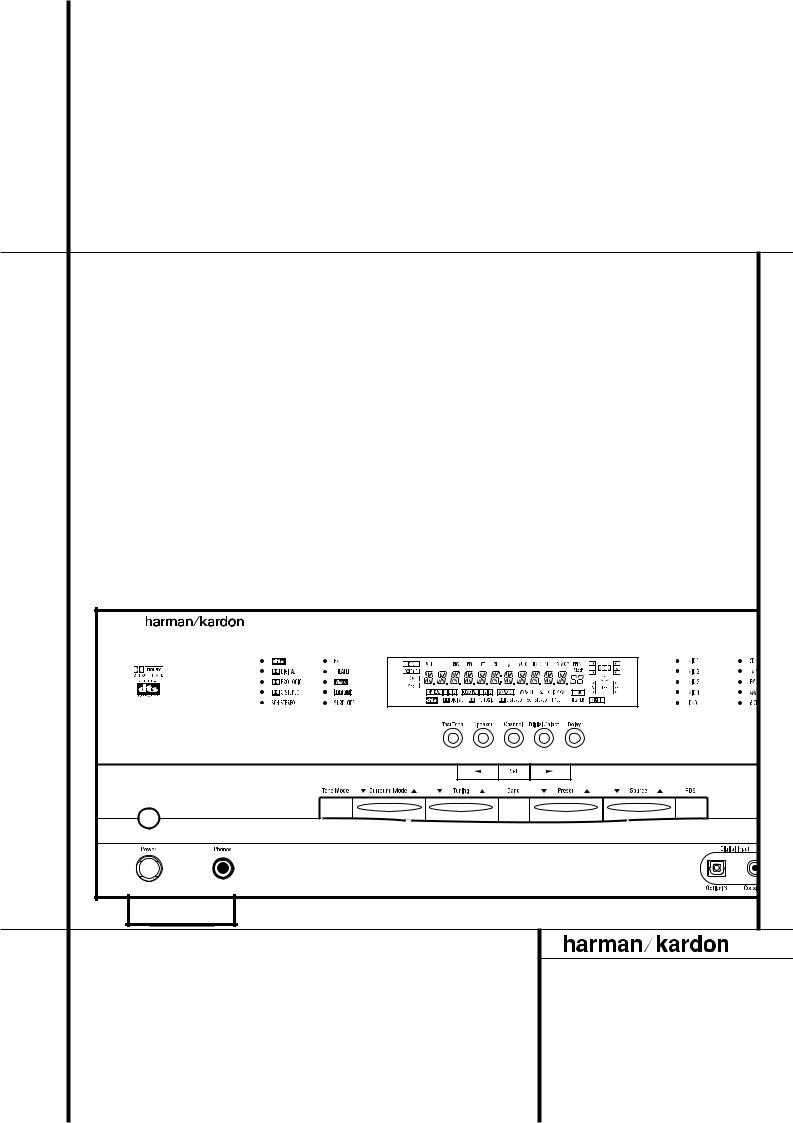
AVR 3000 Audio/Video Receiver |
OWNER’S MANUAL |
AVR 3000 |
® |
Power for the Digital Revolution™ |

Table of Contents
3Introduction
4Safety Information
4Unpacking
5Front Panel Controls
7 Front Panel Information Display
9 Rear Panel Connections
11 Remote Control Functions
14 Installation and Connections
14Audio Equipment Connections
14Video Equipment Connections
15SCART A/V Connections
16System and Power Connections
17System Configuration
17Speaker Selection and Placement
18Settings to be Made With Each Input Used
19Input Setup
19 Surround Setup
19 Speaker Setup
21Adjustments for Other Inputs
21Making Settings independent of selected Input
21Delay Settings
22Night Mode Settings
22Output Level Adjustment
23Using EzSet
23 |
Manual Output Level Adjustment |
25 |
Operation |
25Basic Operation
25Source Selection
25Controls and Use of Headphones
26Surround Mode Chart
27Surround Mode Selection
27 Digital Audio Playback
29Tape Recording
30Output Level Trim Adjustment
306-Channel Direct Input
30Memory Backup
31Tuner Operation
32RDS Operation
34 Advanced Features
34 Display Brightness
34Turn On Volume Level
35Semi OSD Settings
35Full-OSD Time Out Adjustment
36Programming the Remote
36Programming the Remote with Codes
37Macro Programming
38Programmed Device Function
38Volume Punch-Through
39Channel Control Punch-Through
39Transport Control Punch-Through
39Resetting the Remote Memory
40Function List
42 Setup Code Tables
50Troubleshooting Guide
50Processor Reset
51Technical Specifications
Declaration of Conformity
We, Harman Consumer International
2, route de Tours
72500 Château-du-Loir,
FRANCE
declare in own responsibility, that the product described in this owner’s manual is in compliance with technical standards:
EN 55013/6.1990
EN 55020/12.1994
EN 60065:1993
EN 61000-3-2/4.1995
Carsten Olesen
Harman Kardon Europe A/S
10/00
Typographical Conventions
In order to help you use this manual with the remote control, front-panel controls and rear-panel connections, certain conventions have been used.
EXAMPLE – (bold type) indicates a specific remote control or front-panel button, or rear-panel connection jack
EXAMPLE – (OCR type) indicates a message that is visible on the front-panel information display
1– (number in a square) indicates a specific front-panel control
– (number in a circle) indicates a rear-panel connection
0– (number in an oval) indicates a button or indicator on the remote
A– (letter in a square) indicates an indicator in the front-panel display
2 TABLE OF CONTENTS
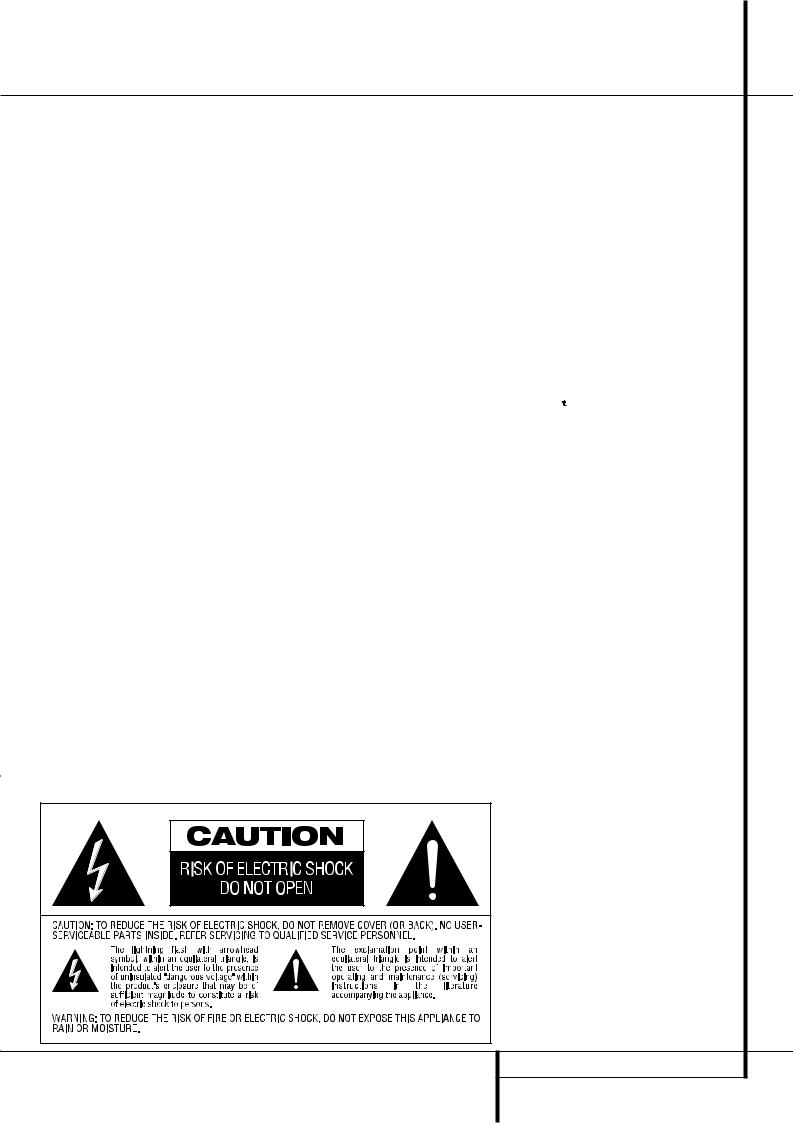
Introduction
Thank you for choosing Harman Kardon!
With the purchase of a Harman Kardon AVR 3000 you are about to begin many years of listening enjoyment. The AVR 3000 has been custom designed to provide all the excitement and detail of movie sound tracks and every nuance of musical selections. With onboard Dolby* Digital and DTS† decoding, the AVR 3000 delivers six discrete channels of audio that take advantage of the digital sound tracks from the latest DVD and LD releases and Digital Television broadcasts.
While complex digital systems are hard at work within the AVR 3000 to make all of this happen, hookup and operation are simple. Color-keyed connections, programmable remote control, and on-screen menus make the AVR 3000 easy to use. To obtain the maximum enjoyment from your new receiver, we urge you to take the time to read through this manual. This will ensure that connections to speakers, source playback units and other external devices are made properly. In addition, a few minutes spent learning the functions of the various controls will enable you to take advantage of all the power the AVR 3000 is able to deliver.
If you have any questions about this product, its installation or its operation, please contact your dealer. He is your best local source of information.
Description and Features
The AVR 3000 is among the most versatile and multi-featured A/V receivers available, incorporating a wide range of listening options. In addition to Dolby Digital and DTS decoding for digital sources, a broad choice of analog surround modes are available for use with sources such as CD, VCR, TV broadcasts and the AVR’s own FM/AM tuner. Along with Dolby Pro Logic*, Dolby 3 Stereo, 5 Ch Stereo and custom Hall and Theater modes, only Harman Kardon receivers offer Logic 7® to
create a wider, more enveloping field environment and more defined fly-overs and pans. Finally, the AVR 3000 is among the very few A/V receivers that offer decoding of MP3 data, so that you may listen to the latest music selections directly from compatible computers or playback devices with the power and fidelity you expect from Harman Kardon.
Another Harman Kardon exclusive is VMAx™, which uses proprietary processing to create an open, spacious sound field even when only two front speakers are available.
In addition to providing a wide range of listening options, the AVR 3000 is easy to configure so that it provides the best results with your speakers and specific listening-room environment. On-screen menus make it simple to enter settings for speakers, inputs and delay times, while our exclusive EzSet™ remote measures a system‘s sound levels and automatically calibrates them for perfectly balanced soundfield presentation.
For the ultimate in flexibility, the AVR 3000 features connections for five video devices, all with both composite and S-Video inputs. Two additional audio inputs are available, and a total of six digital inputs make the AVR 3000 capable of handling all the latest digital audio sources. Coax and optical digital outputs are available for direct connection to digital recorders. Two video recording outputs, preamp outputs for use with external power amplifiers, and a six channel input make the AVR 3000 virtually future-proof, with everything needed to accommodate tomorrow’s new formats right on board.
The AVR 3000’s powerful amplifier uses traditional Harman Kardon high-current design technologies to meet the wide dynamic range of any program selection.
Harman Kardon invented the high-fidelity receiver more than forty-seven years ago. With state- of-the-art circuitry and time-honored circuit designs, the AVR 3000 is one of the finest receivers ever offered by Harman Kardon in its price range.
■Onboard Dolby Digital and DTS Decoding Using Crystal® Chip Technology
■Harman Kardon’s Exclusive Logic 7 and VMAx Modes
■MP3 Decoding for Use with compatible Computers and Digital Audio Players
■




 TM Remote Automatically Sets Output Levels for Optimum Performance
TM Remote Automatically Sets Output Levels for Optimum Performance
■Front-Panel Digital Inputs for Easy Connection to Portable Digital Devices and the Latest Video Game Consoles
■Multiple Digital Inputs and Outputs
■On-Screen Menu and Display System
■6-Channel Direct Input and Preamp Outputs for Easy Expansion and Use with Future Audio Formats
■Remote with Internal Codes Capability
INTRODUCTION 3

Safety Information
Important Safety Information
Verify Line Voltage Before Use
Your AVR 3000 has been designed for use with 220-240-Volt AC current. Connection to a line voltage other than that for which it is intended can create a safety and fire hazard and may damage the unit.
If you have any questions about the voltage requirements for your specific model, or about the line voltage in your area, contact your dealer before plugging the unit into a wall outlet.
Do Not Use Extension Cords
To avoid safety hazards, use only the power cord attached to your unit. We do not recommend that extension cords be used with this product. As with all electrical devices, do not run power cords under rugs or carpets or place heavy objects on them. Damaged power cords should be replaced immediately by an authorized service depot with a cord meeting factory specifications.
Handle the AC Power Cord Gently
When disconnecting the power cord from an AC outlet, always pull the plug, never pull the cord. If you do not intend to use the unit for any considerable length of time, disconnect the plug from the AC outlet.
Do Not Open the Cabinet
There are no user-serviceable components inside this product. Opening the cabinet may present a shock hazard, and any modification to the product will void your guarantee. If water or any metal object such as a paper clip, wire or a staple accidentally falls inside the unit, disconnect it from the AC power source immediately, and consult an authorized service station.
Installation Location
■To assure proper operation and to avoid the potential for safety hazards, place the unit on a firm and level surface. When placing the unit on a shelf, be certain that the shelf and any mounting hardware can support the weight of the product.
■Make certain that proper space is provided both above and below the unit for ventilation. If this product will be installed in a cabinet or other enclosed area, make certain that there is sufficient air movement within the cabinet. Under some circumstances a fan may be required.
■Do not place the unit directly on a carpeted surface.
■Avoid installation in extremely hot or cold locations, or an area that is exposed to direct sunlight or heating equipment.
■Avoid moist or humid locations.
■Do not obstruct the ventilation slots on the top of the unit, or place objects directly over them.
Cleaning
When the unit gets dirty, wipe it with a clean, soft, dry cloth. If necessary, wipe it with a soft cloth dampened with mild soapy water, then a fresh cloth with clean water. Wipe dry immediately with a dry cloth. NEVER use benzene, aerosol cleaners, thinner, alcohol or any other volatile cleaning agent. Do not use abrasive cleaners, as they may damage the finish of metal parts. Avoid spraying insecticide near the unit.
Moving the Unit
Before moving the unit, be certain to disconnect any interconnection cords with other components, and make certain that you disconnect the unit from the AC outlet.
Unpacking
The carton and shipping materials used to protect your new receiver during shipment were specially designed to cushion it from shock and vibration. We suggest that you save the carton and packing materials for use in shipping if you move, or should the unit ever need repair.
To minimize the size of the carton in storage, you may wish to flatten it. This is done by carefully slitting the tape seams on the bottom and collapsing the carton. Other cardboard inserts may be stored in the same manner. Packing materials that cannot be collapsed should be saved along with the carton in a plastic bag.
If you do not wish to save the packaging materials, please note that the carton and other sections of the shipping protection are recyclable. Please respect the environment and discard those materials at a local recycling center.
4 SAFETY INFORMATION
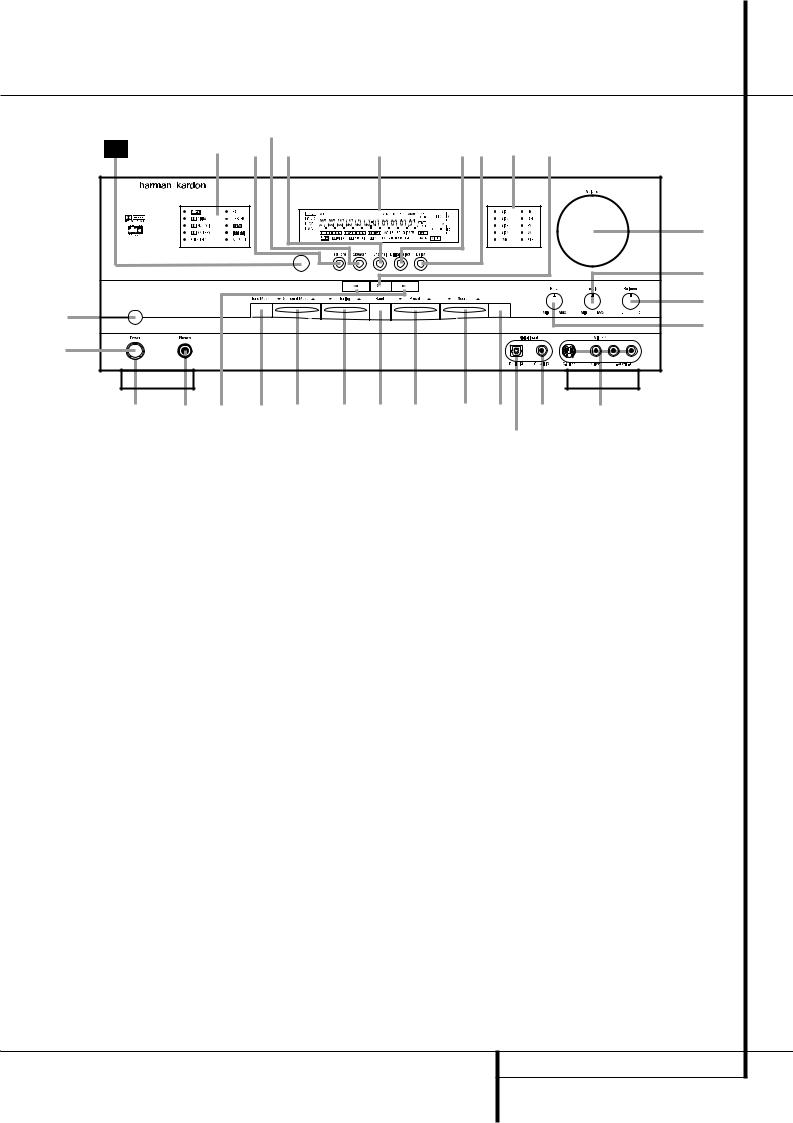
Front Panel Controls
29 |
Ù |
|
|
|
ˆ ı Û |
Ú |
Ò Ô Ó |
|
|
|
AVR 3000 |
|
|
|
|
RDS PTY |
CT RT TA |
|
|
|
|
|
|
( |
|
|
|
|
* |
|
|
|
RDS |
& |
|
|
|
|
|
1 |
|
|
|
^ |
|
|
|
|
|
2 |
|
|
|
|
|
3 4 5 6 7 8 9 ) ! @ $ % |
|
||
|
|
|
# |
|
1 Main Power Switch
2 System Power Control
3 Power Indicator
4 Headphone Jack
5 Selector Buttons
6 Tone Mode
7 Surround Mode Selector
8 Tuning
9 Tuner Band Selector
)Preset Stations Selector
!Input Source Selector @RDS Select Button
#Digital Optical 3 Input $Digital Coax 3 Input %Video 4 input jacks ^Bass Control
&Balance Control
*Treble Control
(Volume Control ÓSet Button
ÔInput Indicators
Delay
ÒDigital Input Selector
ÚMain Information Display
ÛChannel Select Button
ÙSpeaker Select Button
ıTest Tone Selector
ˆSurround Mode Indicators
˜Remote Sensor Window
1Main Power Switch: Press this button to apply power to the AVR 3000. When the switch is pressed in, the unit is placed in a Standby mode, as indicated by the amber LED 3surrounding the System Power Control 2. This button MUST be pressed in to operate the unit. To turn the unit off completely and prevent the use of the remote control, this switch should be pressed until it pops out from the front panel so that the word “OFF” may be read at the top of the switch.
NOTE: This switch is normally left in the “ON” position.
2System Power Control: When the Main Power Switch 1is “ON,” press this button to turn on the AVR 3000; press it again to turn the unit off (to Standby). Note that the Power Indicator surrounding the switch 3will turn green when the unit is on.
3Power Indicator: This LED will be illuminated in amber when the unit is in the Standby mode to signal that the unit is ready to be turned on. When the unit is in operation, the indicator will turn green.
4Headphone Jack: This jack may be used to listen to the AVR 3000’s output through a pair of headphones. Be certain that the headphones have a standard 6.3 mm stereo phone plug. Note that the speakers and all Preamp Outputswill automatically be turned off when the headphone jack is in use.
5Selector Buttons: When you are establishing the AVR 3000’s configuration settings, use these buttons to select from the choices available, as shown in the Main Information Display Ú.
6Tone Mode: Pressing this button enables or disables the Balance, Bass and Treble tone controls. When the button is pressed so that the words TONE IN appear in the Main Information Display Ú, the settings of the
Bass ^and Treble *controls and of the Balance control &will affect the output signals. When the button is pressed so that the words TONE OUT appear in the Main Information Display Ú, the output signal will be “flat,” without any balance, bass or treble alteration.
FRONT PANEL CONTROLS 5

Front Panel Controls
7Surround Mode Selector: Press this button to change the surround mode by scrolling through the list of available modes. Note that Dolby Digital and DTS modes can be selected only when a digital input is used (See page 26 for more information about surround modes.)
8Tuning Selector: Press the left side of the button to tune lower frequency stations and the right side of the button to tune higher frequency stations. When a station with a strong signal is reached, the TUNED indicator Wwill illuminate in the Main Information Display Ú(see page 31 for more information on tuning stations).
9Tuner Band Selector: Pressing this button will automatically switch the AVR to the Tuner mode. Pressing it again will switch between the AM and FM frequency bands, holding it pressed for some seconds will switch between stereo and mono receiving and between automatic and manual tuning mode (See page 31 for more information on the tuner).
)Preset Stations Selector: Press this button to scroll up or down through the list of stations that have been entered into the preset memory. (See page 31 for more information on tuner programming.)
!Input Source Selector: Press this button to change the input by scrolling through the list of input sources.
@RDS Select Button: Press this button to display the various messages that are part of the RDS data system of the AVR 3000’s tuner. (See page 32 for more information on RDS).
#Digital Optical 3 Input: Connect the optical digital audio output of an audio or video product to this jack. When the Input is not in use, be certain to keep the plastic cap installed to avoid dust contamination that might degrade future performance.
$Digital Coax 3 Input: This jack is normally used for connection to the output of portable digital audio devices, video game consoles or other products that have a coax digital jack.
%Video 4 Input Jacks: These audio/video jacks may be used for temporary connection to video games or portable audio/video products such as camcorders and portable audio players.
^Bass Control: Turn this control to modify the low frequency output of the left/right channels by as much as ±10dB. Set this control to a suitable position for your taste or room acoustics.
&Balance Control: Turn this control to change the relative volume for the front left/right channels.
NOTE: For proper operation of the surround modes this control should be at the midpoint or “12 o’clock” position.
*Treble Control: Turn this control to modify the high frequency output of the left/right channels by as much as ±10dB. Set this control to a suitable position for your taste or room acoustics.
(Volume Control: Turn this knob clockwise to increase the volume, counterclockwise to decrease the volume. If the AVR is muted, adjusting volume control will automatically release the unit from the silenced condition.
ÓSet Button: When making choices during the setup and configuration process, press this button to enter the desired setting as shown in the Main Information Display Úinto the AVR 3000’s memory. The set button may also be used to change the display brightness.
(See page 34.)
ÔInput indicators: A green LED will light in front of the input that is currently being used as the source for the AVR 3000.
Delay: Press this button to begin the sequence of steps required to enter delay time settings. (See page 21 for more information on delay times.)
ÒDigital Input Selector: When playing a source that has a digital output, press this button to select between the Optical # and Coaxial $ Digital inputs. (See pages 27-29 for more information on digital audio.)
Ú Main Information Display: This display delivers messages and status indications to help you operate the receiver. (See pages 7–8 for a complete explanation of the Information Display.)
ÛChannel Select Button: Press this button to begin the process of trimming the channel output levels using an external audio source. (For more information on output level trim adjustment, see page 30.)
ÙSpeaker Select Button: Press this button to begin the process of selecting the speaker positions that are used in your listening room. (See page 19 for more information on setup and configuration.)
ıTest Tone Selector: Press this button to begin the process of adjusting the channel output levels using the internal test tone as a reference. (For more information on output level adjustment, see page 22.)
ˆSurround Mode Indicators: A green LED will light in front of the surround mode that is currently in use.
˜ Remote Sensor Window: The sensor behind this window receives infrared signals from the remote control. Aim the remote at this area and do not block or cover it unless an external remote sensor is installed.
6 FRONT PANEL CONTROLS

Front Panel Information Display
P AE ADYAC AB AA X W V UTSR |
Q |
A
B
DTS |
MUTE |
RDS |
PTY |
CT |
RT |
TA |
AUTO TUNED |
ST |
MEMORY PRESET |
O |
|
O |
||
L 0 |
C 0 |
R |
||||||||||||
DOLBY D |
|
|
|
|
|
|
|
|
|
SLEEP |
||||
|
|
|
|
|
|
|
|
|
|
O |
|
O |
||
PCM |
|
|
|
|
|
|
|
|
|
|
O |
|
O |
|
MP3 |
|
|
|
|
|
|
|
|
|
|
|
|||
|
|
|
|
|
|
|
|
|
|
LS |
LFE |
RS |
||
|
OPTICAL |
1 2 3 |
COAXIAL |
1 2 |
3 |
ANALOG |
VMAx NF |
5.1 LOGIC 7 CM |
OSD |
|||||
|
O |
|
O |
|||||||||||
|
|
DIGITAL |
PRO LOGIC |
3-STEREO 5 CH STEREO |
HALL |
THEATER |
NIGHT |
|
|
|||||
C D E F G H I J KLM N O
A Bitstream Indicators |
L Hall Mode Indicator |
W Tuned Indicator |
B Optical Source Indicators |
M OSD Indicator |
X Auto Indicator |
C DTS Mode Indicator |
N Theater Mode Indicator |
Y Main Information Display |
D Dolby Digital Indicator |
O Night Mode Indicator |
AATraffic Indicator |
E Coaxial Source Indicators |
P Mute Indicator |
ABRadiotext Indicator |
F Dolby Pro Logic Indicator |
Q Speaker/Channel Input Indicators |
ACClock Timer Indicator |
G Analog Input Indicator |
R Preset Number/Sleep Timer |
ADProgram Type Indicator |
H Dolby 3 Stereo Indicator |
S Preset Indicator |
AERDS Indicator |
I VMAx Mode Indicator |
T Sleep Indicator |
|
J 5 Channel Stereo Indicator |
U Memory Indicator |
|
K Logic 7 Mode Indicators |
V Stereo Indicator |
|
ABitstream™ Indicators: When the input is a digital source, one of these indicators will light to display the specific type of signal in use.
BOptical Source Indicators: These indicators light to show when a Optical Digital Input has been selected.
CDTS Mode Indicator: This indicator illuminates when the DTS mode is selected.
DDolby Digital Indicator: This indicator illuminates when Dolby Digital mode is selected.
ECoaxial Source Indicators: These indicators light to show when a Coaxial Digital Input has been selected.
FDolby Pro Logic Indicator: This indicator lights when the Dolby ProLogic mode has been selected.
GAnalog Input Indicator: This indicator lights when an analog input source has been selected.
HDolby 3 Stereo Indicator: This indicator lights when the Dolby 3 Stereo Mode has been selected.
IVMAx Mode Indicator: This indicator illuminates to show that the VMAx mode is in use. VMAx F appears when the Far Field VMAx mode is selected; VMAx N appears when the Near Field VMAx mode is selected. (See page 26 for a description of the VMAx Modes.)
J5 Channel Stereo Indicator: This indicator lights when the 5 Channel Stereo mode has been selected.
KLogic 7 Mode Indicators: These indicators illuminate when the Logic 7 mode is in use. LOGIC 7C appears for the Cinema version of Logic 7, LOGIC 7M appears for the Music version of Logic 7. (See page 26 for a description of the Logic 7 Modes.)
LHall Mode Indicator: This indicator lights when the Hall mode has been selected.
MOSD Indicator: When the OSD system is in use, this indicator lights to remind you that the other indicators in this display do not function when the On Screen Display is being used.
NTheater Mode Indicator: This indicator illuminates to show that the Theater mode is in use.
ONight Mode Indicator: This indicator lights when the AVR 3000 is in the Night mode, which preserves the dynamic range of digital program material at low volume levels.
PMute Indicator: This indicator illuminates to remind you that the AVR 3000’s output has been silenced by pressing the Mute button. Press the Mute button again to return to the previously selected output level.
QSpeaker/Channel Input Indicators: These indicators are multipurpose, indicating either the speaker type selected for each channel or the incoming data-signal configuration. The left, center, right, right surround and left surround speaker indicators are composed of three boxes, while the subwoofer is a single box. The center box lights when a “Small” speaker is selected, and the two outer boxes light when “Large” speakers are selected. When none of the boxes are lit for the center, surround or subwoofer channels, no speaker has been selected for that position. (See page 19 for more information on configuring speakers.) The letters inside each of the center boxes display active input channels. For standard analog inputs, only the L and R will light, indicating a stereo input. When a digital source is playing, the indicators will light to display the channels begin received at the digital input. When the letters flash, the digital input has been interrupted. (See page 28 for more information on the Channel Indicators).
RPreset Number/Sleep Timer: When the tuner is in use, these numbers indicate the specific preset memory location in use. (See page 31 for more information on preset stations.) When the Sleep function is in use, these numbers show how many minutes remain before the unit goes into the Standby mode.
FRONT PANEL INFORMATION DISPLAY 7

Front Panel Information Display
SPreset Indicator: This indicator lights when the tuner is in use to show that the Preset Number/Sleep Timer Ris showing the station’s preset memory number. (See page 31 for more information on tuner presets.)
TSleep Indicator: This indicator lights when the Sleep function is in use. The numbers in the Preset/Sleep Number Indicators will show the minutes remaining before the AVR 3000 goes into the Standby mode. (See page 25 for more information on the Sleep function.)
UMemory Indicator: This indicator flashes when entering presets and other information into the tuner’s memory.
VStereo Indicator: This indicator illuminates when an FM station is being tuned in stereo.
WTuned Indicator: This indicator illuminates when a station is being received with sufficient signal strength to provide acceptable listening quality.
XAuto Indicator: This indicator illuminates when the tuner’s Auto mode is in use.
YMain Information Display: This display shows messages relating to the status, input source, surround mode, tuner, volume level or other aspects of unit’s operation.
AATA Traffic Announcement Indicator:
This indicator illuminates if the RDS station tuned somtimes transmits traffic information (see page 32 for more information on RDS).
ABRT Text Indicator: This indicator illuminates when the RDS station tuned is transmitting radiotext (RT) data.
ACClock Time Indicator: This indicator illuminates when the RDS station tuned is transmitting the CT (clock time) code, indicating the current time of day.
ADPTY Indicator: This indicator illuminates when the RDS station tuned is transmitting program type data, or during a PTY search.
AERDS Indicator: This indicator illuminates when the station tuned is transmitting RDS data.
8 FRONT PANEL INFORMATION DISPLAY
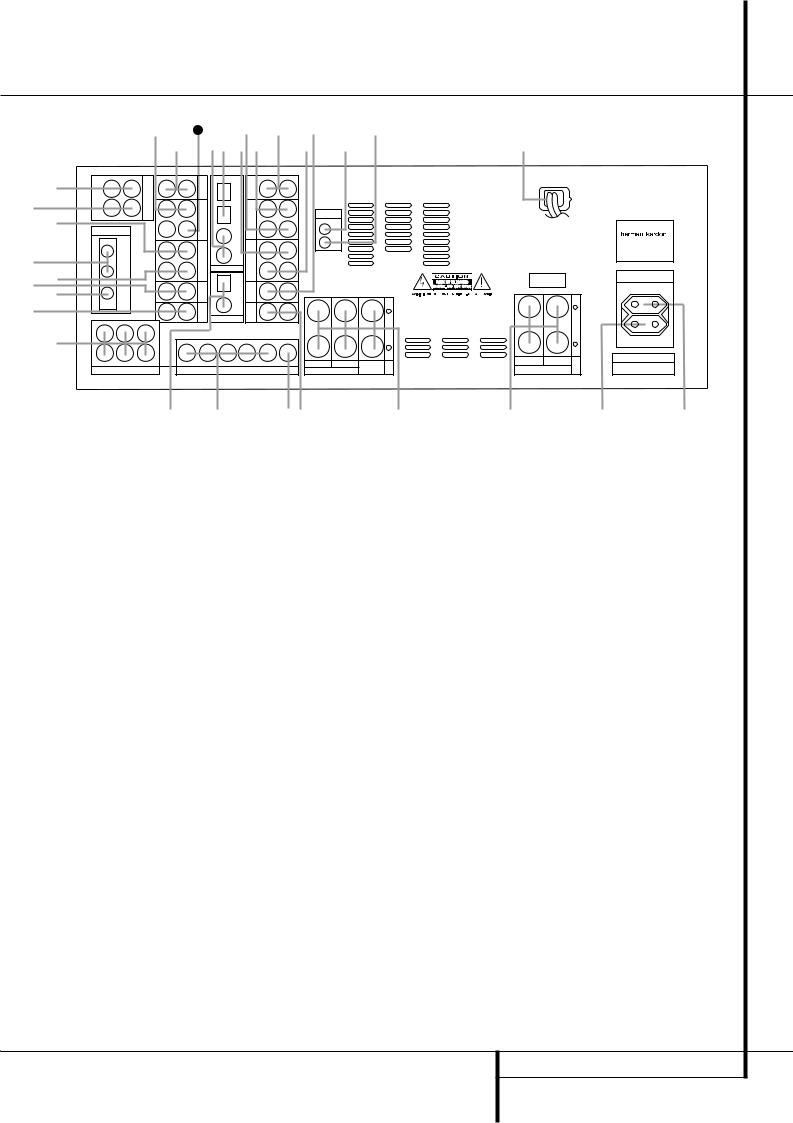
Rear Panel Connections
|
|
|
k |
31 |
|
f |
d |
b |
|
· |
|
|
|
|
j |
|
ih g e |
|
c |
a |
|
° |
|
|
L |
R |
L |
R |
|
VIDEO |
S-VIDEO |
|
|
|
AC INPUT |
|
¡ |
|
|
VID 3 |
|
VID 3 |
|
|
|
|
~230V/50HZ A |
|
|
IN |
1 |
|
|
|
|
|
|||
|
|
|
TAPE |
|
|
|
|
|
|
|
|
™ |
|
|
OUT |
|
OPT |
|
|
|
|
|
|
|
|
IN |
|
IN |
|
|
|
|
|
||
|
|
|
2 |
|
|
REMOTE |
|
|
|||
|
|
|
|
VID 2 |
VID 2 |
|
|
|
|
||
|
£ |
|
|
|
|
|
|
|
|
||
|
ANTENNA |
|
OUT |
|
OUT |
|
|
IN |
|
MODEL NO. AVR 3000 |
|
|
|
|
|
|
|
|
|
||||
|
|
|
|
|
|
|
|
|
|
||
|
|
|
|
|
1 |
|
|
|
|
|
|
|
|
|
|
|
COAX |
|
|
|
OUT |
|
NORTHRIDGE |
|
|
|
|
|
|
|
|
|
|
CALIFORNIA, USA |
|
|
|
AM |
|
IN |
|
IN |
|
|
|
|
MADE IN CHINA |
¢ |
|
|
|
|
2 |
|
|
|
|
|
|
|
|
|
VID 1 |
|
VID 1 |
|
|
|
|
|
|
|
|
GND |
|
OUT |
DIGITAL IN |
OUT |
|
|
|
|
|
|
|
|
|
|
|
|
|
AC OUTLETS |
|||
|
∞ |
|
|
|
|
|
|
|
|
|
|
§ |
|
|
|
|
|
|
|
|
|
~230V/50Hz |
|
|
|
|
|
OPT |
|
|
|
|
|
|
|
|
¶ |
FM |
|
DVD |
|
DVD |
|
|
|
|
UNSWITCHED / 100W MAX |
|
75Ω |
|
|
|
|
|
|
|
|||
|
|
|
|
|
|
|
|
|
|
||
|
|
|
|
|
COAX |
|
|
|
|
|
+ |
• |
|
|
|
CD |
|
MON. |
|
|
|
+ |
|
|
|
|
|
|
|
|
|
||||
|
|
|
|
|
DIGITAL OUT |
OUT |
|
|
|
|
|
|
CENTER |
SL |
FL |
|
|
|
|
|
|
|
|
|
|
|
|
|
|
|
|
|
|||
|
ª |
|
|
|
|
|
|
|
|
|
– |
|
|
|
|
|
|
|
|
|
|
|
SWITCHED / 50W MAX |
|
|
|
|
|
|
|
|
|
|
– |
|
|
|
|
|
|
|
|
|
|
|
|
|
|
SERIAL NO. |
SUBWOOFER |
SR |
FR |
FL |
FR |
SL |
SR |
CENTER |
SUBWOOFER |
RIGHT |
LEFT |
CENTER |
RIGHT |
LEFT |
|
|
||||||||||||
6 CH. DIRECT INPUT |
|
|
|
PRE |
OUT |
|
|
FRONT SPKRS (8Ω) |
SPKR (8Ω) |
SURR. SPKRS (8Ω) |
|||
‚ ⁄ ¤‹ › fi fl ‡
Tape Inputs |
Surround Speaker Outputs |
Video 3 Audio Inputs |
Tape Outputs |
Switched AC Accessory Outlet |
Video 2 Audio Inputs |
Video 1 Audio Inputs |
Unswitched AC Accessory Outlet |
Video 2 Audio Outputs |
AM Antenna |
AC Power Cord |
|
Video 1 Audio Outputs |
Remote IR Output |
|
DVD Audio Inputs |
Remote IR Input |
|
FM Antenna |
DVD Video Inputs |
|
CD Inputs |
Video 1 Video Outputs |
|
6-Channel Direct Inputs |
Video 3 Video Inputs |
|
Digital Audio Outputs |
Video 2 Video Inputs |
|
Preamp Outputs |
Video 2 Video Outputs |
|
Subwoofer Output |
Video 1 Video Inputs |
|
Video Monitor Outputs |
Optical Digital Inputs |
|
Front/Center Speaker Outputs |
Coaxial Digital Inputs |
|
Tape Inputs: Connect these jacks to the PLAY/OUT jacks of an audio recorder.
Tape Outputs: Connect these jacks to the RECORD/INPUT jacks of an audio recorder.
Video 1 Audio Inputs: Connect these jacks to the PLAY/OUT audio jacks on a VCR or other video source.
AM Antenna: Connect the AM loop antenna supplied with the receiver to these terminals. If an external AM antenna is used, make connections to the AM and GND terminals in accordance with the instructions supplied with the antenna.
Video 1 Audio Outputs: Connect these jacks to the RECORD/INPUT audio jacks on a VCR or any other Audio recorder.
DVD Audio Inputs: Connect these jacks to the analog audio jacks on a DVD or other video source.
FM Antenna: Connect the supplied indoor or an optional external FM antenna to this terminal.
CD Inputs: Connect these jacks to the analog output of a compact disc player or CD changer.
6-Channel Direct Inputs: If an external digital audio decoder is used, connect the outputs of that decoder to these jacks.
Digital Audio Outputs: Connect these jacks to the matching digital input connector on a digital recorder such as a CD-R or MiniDisc recorder.
Preamp Outputs: These jacks may be connected to an external power amplifier.
Subwoofer Output: Connect this jack to the line-level input of a powered subwoofer. If an external subwoofer amplifier is used, connect this jack to the subwoofer amplifier input.
REAR PANEL CONNECTIONS 9

Rear Panel Connections
Video Monitor Outputs: Connect these jacks to the composite and/or S-Video input of a TV monitor or video projector to view the onscreen menus and the output of any video source selected by the receiver’s video switcher.
Front/Center Speaker Outputs: Connect these outputs to the matching + or – terminals on your front/center speakers. When making speaker connections, always make certain to maintain correct polarity by connecting the red
(+) terminals on the AVR 3000 to the red (+) terminals on the speaker and the black (–) terminals on the AVR 3000 to the black (–) terminals on the speakers. (See page 14 for more information on speaker polarity.)
Surround Speaker Outputs: Connect these outputs to the matching + or – terminals on your left and right surround speakers. When making speaker connections always make certain to maintain correct polarity by connecting the red (+) terminals on the AVR 3000 to the red (+) terminals on the speakers and the black
(–) terminals on the AVR 3000 to the black (–) terminals on the speakers. See page 14 for more information on speaker polarity.
Switched AC Accessory Outlet: This outlet may be used to power any device that you wish to have turn on when the unit is turned on with the System Power Control switch 2.
Unswitched AC Accessory Outlet: This outlet may be used to power any AC device. The power will remain on at this outlet regardless of whether the AVR 3000 is on or off (in Standby), provided that the Main Power switch 1is on.
Note: The total power consumption of all devices connected to the accessory outlets should not exceed 100 watts from the
Unswitched Outlet and 50 W from the Switched Outlet .
AC Power Cord: Connect the AC plug to an unswitched AC wall output.
Remote IR Output: This connection permits the IR sensor in the receiver to serve other remote controlled devices. Connect this jack to the “IR IN” jack on Harman Kardon or other compatible equipment.
Remote IR Input: If the AVR 3000’s frontpanel IR sensor is blocked due to cabinet doors or other obstructions, an external IR sensor may be used. Connect the output of the sensor to this jack.
DVD Video Inputs: Connect these jacks to the composite or S-Video output jacks on a DVD player or other video source.
Video 1 Video Outputs: Connect these jacks to the RECORD/INPUT composite or S-Video jack on a VCR.
Video 3 Video Inputs: Connect these jacks to the PLAY/OUT composite or S-Video jacks on any video source.
Video 2 Video Inputs: Connect these jacks to the PLAY/OUT composite or S-Video jacks on a second VCR or other video source.
Video 2 Video Outputs: Connect these jacks to the RECORD/INPUT composite or S-Video jacks on a second VCR.
Video 1 Video Inputs: Connect these jacks to the PLAY/OUT composite or S-Video jacks on a VCR or other video source.
Optical Digital Inputs: Connect the optical digital output from a DVD player, HDTV receiver, LD player, MD player or CD player to these jacks. The signal may be either a Dolby Digital signal, a DTS signal or a standard PCM digital source.
Coaxial Digital Inputs: Connect the coax digital output from a DVD player, HDTV receiver, LD player, MD player or CD player to these jacks. The signal may be either a Dolby Digital signal, DTS signal or a standard PCM digital source. Do not connect the RF digital output of an LD player to these jacks.
Video 3 Audio Inputs: Connect these jacks to the PLAY/OUT audio jacks on any audio or video source.
Video 2 Audio Inputs: Connect these jacks to the PLAY/OUT audio jacks on a VCR or other video source.
Video 2 Audio Outputs: Connect these jacks to the RECORD/INPUT audio jacks on a VCR or any Audio recorder.
Note: Either the Video or S-Video output of any S-Video source must be connected to the AVR 3000, not both in parallel, otherwise the video may be disturbed or its performance be adversely effected.
10 REAR PANEL CONNECTIONS
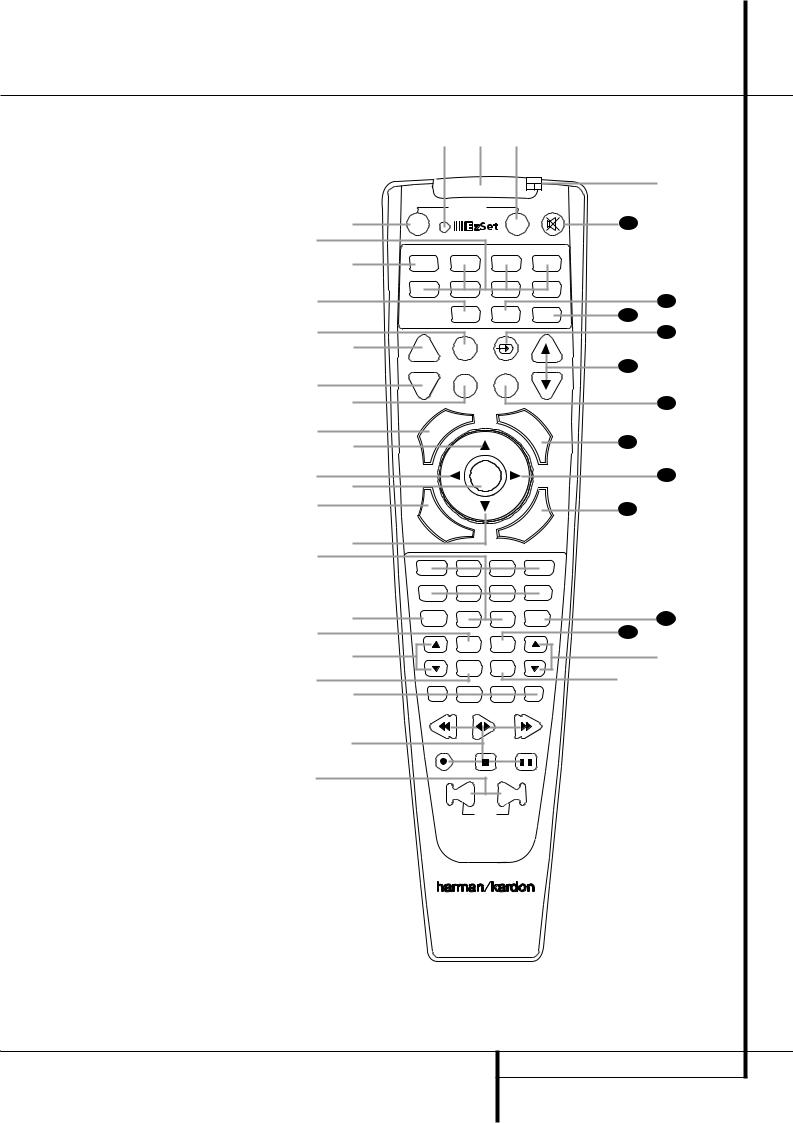
Remote Control Functions
0Power On Button
1IR Transmitter Window
2Program/SPL Indicator
3Power Off Button
4Input Selectors
5AVR Selector
6AM/FM Tuner Select
7EzSet Sensor Microphone
8Test Button
9Sleep Button
ASurround Mode Selector
BNight Mode
CChannel Select Button
D⁄/ ¤ Buttons
E‹ Button
FSet Button
GDigital Select
HNumeric Keys
ITuner Mode
JDirect Button
KTuning Up/Down
LOSD Button
MMacro Buttons
NTransport Controls
OSkip Up/Down Buttons
PRDS Select Button
QPreset Up/Down
Clear Button
Memory Button Delay/Prev. Ch.
!› Button
"Speaker Select
#Spare Button
$Volume Up/Down
%TV/Video Selector
&SPL Indicator Select
'6-Channel Direct Input
Mute
NOTE: The function names shown here are each button’s feature when used with the AVR. Most buttons have additional functions when used with other devices. See page 40-41 for a list of these functions.
c b a
|
|
POWER |
|
|
|
|
|
|
|
|
|
d |
OFF |
|
TM |
ON |
|
|
|
|
|
|
|
e |
|
|
|
|
|
|
|
|
|
|
|
f |
AVR |
DVD |
CD |
|
|
TAPE |
|||||
|
VCR |
TV |
CBL/SAT |
|
|
|
|
|
|
|
|
g |
VID1 |
VID2 |
VID3 |
|
|
VID4 |
|||||
|
|
|
|
|
|
|
|
|
|
|
|
|
|
AM/FM |
6 CH. |
|
|
|
SPL |
|
|||
i |
|
|
|
|
|
|
|
|
|
|
|
j |
SLEEP |
TEST |
|
|
|
|
|
|
|
|
|
|
|
|
|
|
|
|
|
|
|
|
|
|
PR |
NIGHT |
|
|
|
|
VOL. |
||||
k |
SURR. |
|
|
|
|
|
|
|
|
|
|
|
|
|
|
|
|
|
|
|
|
|
|
l |
|
|
|
|
M |
|
|
|
|
||
|
|
|
|
|
|
|
|
|
|||
|
|
|
|
|
|
|
E |
|
|
|
|
|
|
|
|
|
|
|
N |
|
|
||
|
|
|
|
S |
|
|
|
U |
|
|
|
|
|
|
|
|
|
|
|
|
|
|
|
m |
H |
|
|
P |
|
|
|
|
|
|
|
|
|
K |
|
|
|
|
|
|
|||
|
. |
|
|
|
|
|
|
|
|
||
|
C |
|
|
R |
|
|
|
|
|||
n |
|
|
|
|
|
|
|
|
|
|
|
|
|
|
|
|
|
|
|
|
|
|
|
o |
|
SET |
|
|
|
|
|
|
|
|
|
p |
|
|
|
|
|
|
|
|
|
|
|
q |
D |
|
|
|
|
|
|
|
|
|
|
|
I |
|
|
|
|
|
Y |
|
|
|
|
|
I |
|
|
|
|
|
|
|
|
|
|
|
G |
|
|
|
|
A |
|
|
|
|
|
|
T |
|
|
|
|
|
|
|
L |
||
|
A |
|
|
|
L |
|
|
|
|
||
|
|
|
E |
|
|
|
|
A |
|||
|
L |
|
|
D |
|
|
|
|
M |
|
|
|
|
|
|
|
|
|
|
|
|
||
|
|
|
|
|
|
|
|
|
|
|
|
n |
|
|
|
|
|
|
|
R |
|
|
|
|
|
|
|
|
|
O |
|
|
|
||
|
|
|
|
|
N |
|
|
|
|
||
r |
1 |
2 |
3 |
|
|
|
4 |
|
|
|
|
|
|
|
|
|
|
|
|
||||
|
5 |
6 |
7 |
|
|
8 |
|
|
|
|
|
s |
TUN-M |
9 |
0 |
MEM |
|
|
|
||||
|
|
|
|
|
|
||||||
t |
|
|
|
|
|
|
|
|
|
|
|
u |
|
DIRECT |
CLEAR |
|
|
|
|
|
|
|
|
TUNING |
|
|
PRESET |
|
|
||||||
|
|
OSD |
RDS |
|
|
|
|
|
|
|
|
v |
|
|
|
|
|
|
|
|
|
|
|
w |
M1 |
M2 |
M3 |
M4 |
|
|
|
|
|||
x |
|
|
|
|
|
|
|
|
|
|
|
y |
|
|
|
|
|
|
|
|
|
|
|
|
|
DWN |
UP |
|
|
|
|
|
|
|
|
|
|
SKIP |
|
|
|
|
|
|
|
|
|

 3000
3000
h
38
37
36
35
34
33
32
31
30
29
28
`
z
REMOTE CONTROL FUNCTIONS 11

Remote Control Functions
IMPORTANT NOTE: The AVR 3000’s remote may be programmed to control up to seven devices, including the AVR 3000. Before using the remote, it is important to remember to press the Input Selector button 4that corresponds to the unit you wish to operate. In addition, the AVR 3000’s remote is shipped from the factory to operate the AVR 3000 and most Harman Kardon CD or DVD players and cassette decks. The remote is also capable of operating a wide variety of other products using the control codes that are part of the remote. Before using the remote with other products, follow the instructions on pages 36 to program the proper codes for the products in your system.
It is also important to remember that many of the buttons on the remote take on different functions, depending on the product selected using the Input Selectors. The descriptions shown here primarily detail the functions of the remote when it is used to operate the AVR 3000. (See page 40 for information about alternate functions for the remote’s buttons.)
0Power On Button: Press this button to turn on the power to a device selected by pressing one of the Input Selectors 4(except Tape).
1IR Transmitter Window: Point this window towards the AVR 3000 when pressing buttons on the remote to make certain that infrared commands are properly received.
2Program/SPL Indicator: This three-color indicator is used to guide you through the process of programming the remote and it is also used as a level indicator when using the remote’s EzSet capabilities. (See page 23 for more information on setting output levels, and see page 36 for information on programming the remote.)
3Power Off Button: Press this button to place the AVR 3000 or a selected device unit in the Standby mode.
4Input Selectors: Pressing one of these buttons will perform three actions at the same time. First, if the AVR is not turned on, this will power up the unit. Next, it will select the source shown on the button as the input to the AVR. Finally, it will change the remote control so that it controls the device selected. After pressing one of these buttons you must press the AVR Selector button 5again to operate the AVR’s functions with the remote.
5AVR Selector: Pressing this button will switch the remote so that it will operate the AVR’s functions. If the AVR is in the Standby mode, it will also turn the AVR on.
6AM/FM Tuner Select: Press this button to select the AVR’s tuner as the listening choice. Pressing this button when the tuner is in use will select between the AM and FM bands.
7EzSet Sensor Microphone: The sensor microphone for the EzSet microphone is behind these slots. When using the remote to calibrate speaker output levels using EzSet, be sure that you do not hold the remote in a way that covers these slots. (See page 23 for more information on using EzSet).
8Test Tone: Press this button to begin the sequence used to calibrate the AVR 3000’s output levels. (See page 22 for more information on calibrating the AVR 3000.)
9Sleep Button: Press this button to place the unit in the Sleep mode. After the time shown in the display, the AVR 3000 will automatically go into the Standby mode. Each press of the button changes the time until turn-off in the following order:
|
|
90 |
|
80 |
|
|
70 |
|
|
60 |
|
50 |
|
|
|
|
min |
|
min |
|
min |
|
min |
|
|
min |
|
||
|
|
|
|
|
|
|
|
|
|
|
|
|
|
|
|
40 |
|
30 |
|
|
20 |
|
|
10 |
|
|
OFF |
||
|
|
|
|
|
|
|
|
|||||||
|
|
min |
|
min |
|
min |
|
min |
|
|
||||
|
|
|
|
|
|
|
|
|
||||||
Hold the button pressed for two seconds to turn off the Sleep mode setting.
Note that this button is also used to change channels on your TV, VCR and SAT receiver when selected.
ASurround Mode Selector: Press this button to begin the process of changing the surround mode. After the button has been pressed, use the ⁄/¤ buttons Dto select the desired surround mode (See page 27 for more information). Note that this button is also used to tune channels when the TV, VCR and SAT receiver is selected using the Input Selector 4.
BNight Mode: Press this button to activate the Night mode. This mode is available only with Dolby Digital encoded digital sources, and it preserves dialog (center channel) intelligibilty at low volume levels (See page 29 for more information).
CChannel Select Button: This button is used to start the process of setting the AVR 3000’s output levels with an external source. Once this button is pressed, use the ⁄/¤ buttons Dto select the channel being adjusted, then press the Set button F, followed by the ⁄/¤ buttons again, to change the level setting. (See page 30 for more information.)
D⁄/¤ Buttons: These are multi-purpose buttons. They will be used most frequently to select a surround mode. To change the surround mode, first press the SURR/CH ¤ button A. Next press these buttons to scroll up or down through the list of surround modes that appear in the Main Information Display Ú. These buttons are also used to increase or decrease output levels when configuring the unit with either the internal test tone or an external source. They are also used to enter delay time settings after the Delay button
has been pressed.
When the AVR 3000 remote is being programmed for the codes of another device, these buttons are also used in the “Auto Search” process (See page 36 for more information on programming the remote.)
E‹ Button: This button is used to change the menu selection or setting during some of the setup procedures for the AVR.
FSet Button: This button is used to enter settings into the AVR 3000’s memory. It is also used in the setup procedures for delay time, speaker configuration and channel output level adjustment.
GDigital Select: Press this button to assign one of the digital inputs #$ to a source. (See page 28 for more information on using digital inputs.)
HNumeric Keys: These buttons serve as a ten-button numeric keypad to enter tuner preset positions. They are also used to select channel numbers when TV, VCR or Sat receiver has been selected on the remote, or to select track numbers on a CD, DVD or LD player, depending on how the remote has been programmed.
ITuner Mode: Press this button when the tuner is in use to select between automatic tuning and manual tuning. When the button is pressed so that the AUTO indicator Xgoes out, pressing the Tuning buttons K8will move the frequency up or down in single-step increments. When the FM band is in use and the AUTO indicator Xis on, pressing this button will change to monaural reception making even week stations audible. (See page 31 for more information.)
12 REMOTE CONTROL FUNCTIONS

Remote Control Functions
JDirect Button: Press this button when the tuner is in use to start the sequence for direct entry of a station’s frequency. After pressing the button simply press the proper Numeric Keys Hto select a station (See page 31 for more information on the tuner).
KTuning Up/Down: When the tuner is in use, these buttons will tune up or down through the selected frequency band. If the Tuner Mode button Ihas been pressed or the Band button @on the front panel was held pressed so that the AUTO indicator Xis illuminated, pressing either of the buttons will cause the tuner to seek the next station with acceptable signal strength for quality reception. When the AUTO indicator Xis NOT illuminated, pressing these buttons will tune stations in single-step increments. (See page 31 for more information.)
LOSD Button: Press this button to activate the On Screen Display (OSD) system used to set up or adjust the AVR 3000’s parameters.
MMacro Buttons: Press these buttons to store or recall a “Macro”, which is a pre-programmed sequence of commands stored in the remote. (See page 37 for more information on storing and recalling macros.)
N Transport Buttons: These buttons do not have any functions for the AVR, but they may be programmed for the forward/reverse play operation of a wide variety of CD or DVD players, and audio or videocassette recorders. (See page 36 for more information on programming the remote.)
OSkip Up/Down Buttons: These buttons do not have a direct function with the AVR 3000, but when used with a compatibly programmed CD or DVD changer they will change the tracks on the disc currently being played in the changer.
PRDS Select Button: Press this button to display the various messages that are part of the RDS data system of the AVR 3000’s tuner. (See page 32 for more information on RDS).
QPreset Up/Down: When the tuner is in use, press these buttons to scroll through the stations programmed into the AVR 3000’s memory. When CD or DVD is selected using the Input Selector button 4, these buttons may function as Slow Fwd/Rev (DVD) or ”+10” (CD).
Clear Button: Press this button to clear incorrect entries when using the remote to directly enter a radio station’s frequency.
Memory Button: Press this button to enter a radio station into the AVR 3000’s preset memory. After pressing the button the MEMORY indicator Uwill flash; you then have five seconds to enter a preset memory location using the Numeric Keys H. (See page 31 for more information.)
Delay/Prev Ch.: Press this button to begin the process for setting the delay times used by the AVR 3000 when processing surround sound. After pressing this button, the delay times are entered by pressing the Set button Fand then using the ⁄/¤ buttons Dto change the setting. Press the Set button again to complete the process. (See page 21 for more information.)
!› Button: Press this button to change a setting or selection when configuring many of the AVR’s settings.
"Speaker Select: Press this button to begin the process of configuring the AVR 3000’s Bass Management System for use with the type of speakers used in your system. Once the button has been pressed, use the ⁄/¤ buttons Dto select the channel you wish to set up. Press the Set button Fand then select the speaker type (see page 19 for more information.)
#Spare Button: This button does not have any function for the operation of the AVR3000, but it can turn on/off the Multiroom system on other Harman Kardon AV-receivers with that feature and the Sub-function on DVD players.
$Volume Up/Down: Press these buttons to raise or lower the system volume.
%TV/Video Button: This button does not have a direct function on the AVR 3000, but when used with a compatibly programmed VCR, DVD or satellite receiver that has a “TV/Video” function, pressing this button will switch between the output of the player or receiver and the external video input to that player. Consult the Owner’s Manual for your specific player or receiver for the details of how it implements this function.
&SPL Indicator Select: This button activates the AVR 3000’s EzSet function to quickly and accurately calibrate the AVR 3000’s output levels. Press and hold the button for three seconds and then release it. Note that the Test Tone will begin circulating, and the Program Indicator 2will change colors. During this sequence, EzSet will automatically adjust the output levels for all channels until they are equal, as shown by the Program Indicator lighting green for each channel. (See page 23 for more information on EzSet.)
'6-Ch. Direct Input: Press this button to select the component connected to the 6-Ch. Direct Input as the source
Mute: Press this button to momentarily silence the AVR 3000 or TV set being controlled, depending on which device has been selected.
When the AVR 3000 remote is being programmed to operate another device, this button is pressed with the Input Selector button 4to begin the programming process. (See page 36 for more information on programming the remote.)
NOTE: As any of the remote buttons pressed is active with the device selected, the corresponding Selector button 45will briefly flash red to confirm your selection.
REMOTE CONTROL FUNCTIONS 13

Installation and Connections
After unpacking the unit, and placing it on a solid surface capable of supporting its weight, you will need to make the connections to your audio and video equipment.
Audio Equipment Connections
We recommend that you use high-quality interconnect cables when making connections to source equipment and recorders to preserve the integrity of the signals.
When making connections to audio source equipment or speakers it is always a good practice to unplug the unit from the AC wall outlet. This prevents any possibility of accidentally sending audio or transient signals to the speakers that may damage them.
1. Connect the analog output of a CD player to the CD inputs .
NOTE: When the CD player has both fixed and variable audio outputs it is best to use the fixed output unless you find that the input to the receiver is so low that the sound is noisy, or so high that the signal is distorted.
2.Connect the analog Play/Out jacks of a cassette deck, MD, CD-R or other audio recorder to the Tape Input jacks . Connect the analog Record/In jacks on the recorder to the Tape Output jacks on the AVR 3000.
3.Connect the output of any digital sources to the appropriate input connections on the AVR 3000 front or rear panel. Note that the Optical and Coaxial digital inputs
#$may be used with a Dolby Digital or DTS source or the output of a conventional CD, MD or LD player’s PCM (S/P-DIF) output.
4.Connect the Coaxial or Optical Digital Outputs on the rear panel of the AVR to the matching digital input connections on a CD-R or MiniDisc recorder.
5.Assemble the AM Loop Antenna supplied with the unit as shown below. Connect it to the AM and GND screw terminals .
6. Connect the supplied FM antenna to the FM
(75 ohm) connection . The FM antenna may be an external roof antenna, an inside powered or wire lead antenna or a connection from a cable system. Note that if the antenna or connection uses 300-ohm twin-lead cable, you must use a 300-ohm-to-75-ohm adapter to make the connection.
7. Connect the front, center and surround speaker outputs to the respective speakers.
To assure that all the audio signals are carried to your speakers without loss of clarity or resolution, we suggest that you use high-quality speaker cable. Many brands of cable are available and the choice of cable may be influenced by the distance between your speakers and the receiver, the type of speakers you use, personal preferences and other factors. Your dealer or installer is a valuable resource to consult in selecting the proper cable.
Regardless of the brand of cable selected, we recommend that you use a cable constructed of fine, multistrand copper with an area greater than 2 mm2.
Cable with an area of 1.5 mm2 may be used for short runs of less than 4 m. We do not recommend that you use cables with an area less than 1mm2 due to the power loss and degradation in performance that will occur.
Cables that are run inside walls should have the appropriate markings to indicate listing with UL, CSA or other appropriate testing agency standards. Questions about running cables inside walls should be referred to your installer or a licensed electrical contractor who is familiar with the applicable local building codes in your area.
When connecting wires to the speakers, be certain to observe proper polarity. Remember to connect the “negative” or “black” wire to the same terminal on both the receiver and the speaker. Similarly, the “positive” or “red” wire should be connected to like terminals on the AVR 3000 and speaker.
NOTE: While most speaker manufacturers adhere to an industry convention of using black terminals for negative and red ones for positive, some manufacturers may vary from this configuration. To assure proper phase and optimal performance, consult the identification plate on your speaker or the speaker’s manual to verify polarity. If you do not know the polarity of your speaker, ask your dealer for advice before proceeding, or consult the speaker’s manufacturer.
We also recommend that the length of cable used to connect speaker pairs be identical. For example, use the same length piece of cable to connect the front-left and front-right or sur- round-left and surround-right speakers, even if the speakers are a different distance from the AVR 3000.
8. Connections to a subwoofer are normally made via a line level audio connection from the Subwoofer Output to the line-level input of a subwoofer with a built-in amplifier. When a passive subwoofer is used, the connection first goes to a power amplifier, which will be con-
nected to one or more subwoofer speakers. If you are using a powered subwoofer that does not have line-level input connections, follow the instructions furnished with the speaker for connection information.
Note: Speaker sets with two front satellites and a passive subwoofer must be connected to the front speaker outputs only rather than to the
Subwoofer Output .
Video Equipment Connections
Video equipment is connected in the same manner as audio components. Again, the use of highquality interconnect cables is recommended to preserve signal quality. To ensure best video performance S-Video sources should be connected to the AVR3000 only with their S-Video In/ Outputs, not with their composite video connectors too.
1.Connect a VCR’s audio and video Play/Out jacks to the Video 1 or Video 2 In jackson the rear panel. The Audio and Video Record/In jacks on the VCR should be connected to the Video 1 or Video 2 Out jacks
on the AVR 3000.
2.Connect the analog audio and video outputs of a satellite receiver, cable TV converter or television set or any other video source to the Video 2 (if not in use) or Video 3 jacks.
3.Connect the analog audio and video outputs of a DVD or laser disc player to the DVD jacks
.
4.Connect the Video Monitor Out jacks on the receiver to the composite and S-Video input of your television monitor or video projector.
Video Connection Note:
•S-Video or Composite video signals may only be viewed in their native formats and will not be converted to the other format. But the OSD will be viewed on the TV screen in any case, with Video or S-Video input selected on the TV.
14 INSTALLATION AND CONNECTIONS
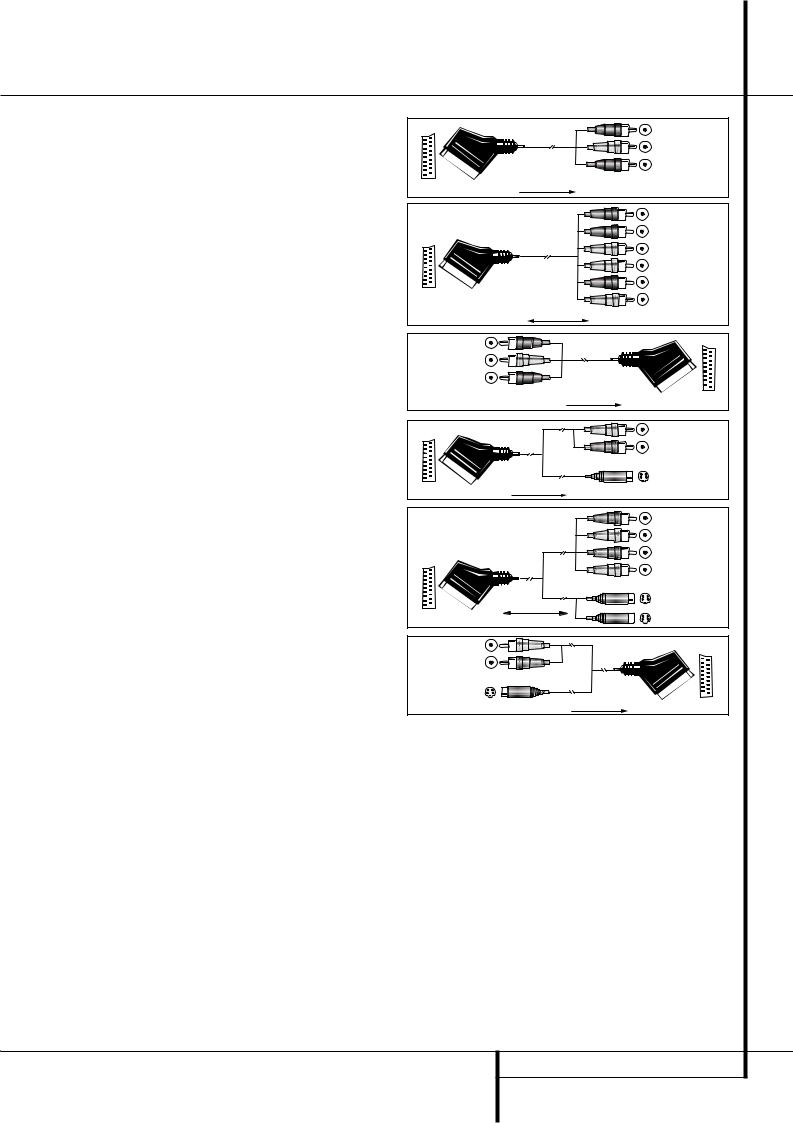
Installation and Connections
SCART A/V Connections
For the connections described above your video device needs RCA (cinch) connectors or/and S- Video connectors for all Audio and Video signals: Any normal video device (Not SVHS or High 8) for only playback needs 3 RCA jacks, VCRs for record and playback even 6 RCA jacks. Any S-Video device (SVHS, High 8) needs 2 RCA (Audio) and 1 S-Video jack (Video), if it´s a playback unit, or 4 RCA (Audio In/Out) and 2 S-Video (Video In/Out) jacks, if it´s a recording VCR.
Many european video devices are equipped with RCA (Cinch) or S-Video jacks only partially, not for all audio and video in/outputs needed as described above, but with a so called Scart or Euro-AV connector (almost rectangular jack with 21 pins, see drawings on this page).
In that case the following Scart to Cinch adapters or cables are needed:
•Units for playback, such as satellite receivers, camcorders, DVD or LD players, need an adapter from Scart to 3 RCA plugs, see fig. 1 (normal video devices) or from Scart to 2 RCA+1 S- Video plugs, see fig. 4 (S-Video devices).
•HiFi VCRs need an adapter from Scart to 6 RCA plugs, see fig. 2 (normal video), or from Scart to 4 Audio+2S-Video jacks, see fig. 5 (S-Video VCR). Read carefully the instruction attached to the adapter to find which of the six plugs is used for the record signal to the VCR (connect with the AVR´s Out jacks) and for the playback signal from the VCR (connect with the AVR´s In jacks). Do not misconnect Audio and Video signals. Don´t hesitate to consult your dealer, if you are uncertain.
•If you use only normal video devices the TV monitor needs an adapter from 3 RCA plugs to Scart (fig. 3) only. If also S-Video devices are used an adapter from 2 RCA+1S-Video plugs to Scart is needed additionally (fig. 6), connected to the SCART input on your TV that is provided for S-Video.
Note that only the video plugs (the "yellow" cinch plug in fig. 3 and the S-Video plug in fig. 6) must be connected to the TV Monitor Output, and the volume on the TV must be reduced to minimum.
Important Note for Adapter Cables:
If the cinch connectors of the adapter you’ll use are labeled, connect the Audio and Video ”In” plugs with the corresponding Audio and Video ”In” jacks on the AVR 3000 (and with a VCR connect the ”Out” plugs to the ”Out” jacks on the AVR). Note that with some adapter types it may be just turned around: If no signal is audible/ visible when the VCR is playing connect the “Out” plugs to the ”In” jacks on the AVR and turned around. If the adapter plugs are not labeled in that way, pay attention to the signal flow direc-
|
Blackck |
|
Figure 1: |
Yellowow |
|
SCART/Cinch-Adapter for |
||
Red |
||
playback; |
||
signal flow: |
|
|
SCART → Cinch |
|
|
|
Black |
|
|
Red |
|
|
Blue1 |
|
Figure 2: |
Yellow |
|
Green1 |
||
SCART/Cinch-Adapter for |
||
record and playback; |
White |
|
signal flow: |
|
|
SCART ↔ Cinch |
|
|
|
Black |
|
Figure 3: |
Yellow |
|
Cinch/SCART-Adapter for |
Red |
|
playback; |
||
|
||
signal flow: |
|
|
Cinch → SCART |
|
|
|
ot |
|
|
Red |
|
Figure 4: |
Schwarz |
|
SCART/S-Video Adapter |
Black |
|
|
||
for playback; |
In |
|
signal flow: |
S-Video In |
|
|
||
SCART → Cinch |
|
Figure 5:
SCART/S-Video Adapter
for record and playback;
signal flow:
SCART ↔ Cinch
Figure 6:
SCART/S-Video Adapter
for playback;
signal flow:
Cinch → SCART
BlackSchwarz
RedRot
BlueBlau1
YellowGelb
SS--VideoInIn
SS--VideoOut
Rot
Red
SchwarzBlack
SS--VideoOut
1 Also other colours possible, e.g. brown and grey.
tions as shown in the diagrams above and in the instruction attached to the adapter. If uncertain, don’t hesitate to consult your dealer.
Important Notes for S-Video connections:
1.Only the S-Video In/Out of S-Video devices must be connected to the AVR, NOT both, normal video and S-Video In/Outputs (except the TV, see item 2).
2.Like most common AV units the AVR 3000 does not convert the Video signal to S-Video or vice versa. Thus both connections must be made from the AVR 3000 to the TV if both, Video and S-Video sources, are used, and the appropriate input on the TV must be selected.
Important Note for the Use of SCART-Cinch Adapters:
When video sources are connected to the TV directly with a SCART cable, specific control signals apart from Audio/Video signals will be fed to the TV. These specific signals are: With all video sources, the signal for automatic input selection that switches the TV automatically to the appropriate input as soon as the video source is started. And with DVD players, the signals automatically turning the TV to 16:9 format (with switchable 4:3 TVs) and turning the RGB video decoder of the TV on or off, depending on the DVD player´s setting. With any adapter cable, these control signals will be lost and the appropriate setting of the TV must be made manually.
INSTALLATION AND CONNECTIONS 15

Installation and Connections
System and Power Connections
The AVR 3000 is designed for flexible use with external control components and power amplifiers.
Remote Control Extension
If the receiver is placed behind a solid or smoked glass cabinet door, the obstruction may prevent the remote sensor from receiving commands. In this event, the remote sensor of any Harman Kardon or other compatible device, not covered by the door, or an optional remote sensor may be used. Connect the Remote IR Output of that device or the output of the remote sensor to the Remote IR Input jack .
If other components are also prevented from receiving remote commands, only one sensor is needed. Simply use this unit’s sensor or a remote eye by running a connection from the Remote IR Output jack to the Remote IR Input jack on Harman Kardon or other compatible equipment.
NOTE: All remotely controlled components must be linked together in a daisy chain. Connect the IR OUT jack of one unit to the IR IN of the next to establish this chain.
External Audio Power Amplifier Connections
If desired, the AVR 3000 may be connected to optional, external audio power amplifiers.
When an external amplifier is used, connect the Preamp Out jacks to the inputs on the amplifier. Note that when external amplifiers or devices are used, the volume control is still controlled by the AVR, although additional volume controls on the external device may impact the volume settings and output levels from the AVR.
External Audio Decoder Connection
To provide for ultimate flexibility, the AVR 3000 may be used in conjunction with optional, external decoders for digital audio systems other than the AVR 3000’s own built-in Dolby Digital and DTS decoding system or with DVD players having those decoders integrated. If an external decoder is used, connect the output jacks of the decoder to the 6-Channel Direct inputs , making sure to match channels.
These jacks may also be used for connections to devices such as DVD players or High Definition Television (HDTV) sets or decoders that feature built-in digital surround decoders. Although the digital decoding system in the AVR 3000 will typically provide audio performance that is superior to other decoders, you may use these jacks to provide an additional 6-channel input for connection to a DVD player or HDTV set with a built-in decoder and discrete 6-channel analog outputs.
AC Power Connections
This unit is equipped with two accessory AC outlets. They may be used to power accessory devices, but they should not be used with highcurrent draw equipment such as power amplifiers. The total power draw to the Unswitched Outlet must not exceed 100 watts, that to the Switched Outlet 50 watts.
The Switched outlet will receive power only when the unit is on completely. This is recommended for devices that have no power switch or a mechanical power switch that may be left in the “ON” position.
NOTE: Many audio and video products go into a Standby mode when they are used with switched outlets, and cannot be fully turned on using the outlet alone without a remote control command.
The Unswitched outlet will receive power as long as the unit is plugged into a powered AC outlet and the Main Power Switch 1is on.
Finally, when all connections are complete, plug the power cord into a nonswitched 220-240-volt AC wall outlet. You’re almost ready to enjoy the AVR 3000!
16 INSTALLATION AND CONNECTIONS
